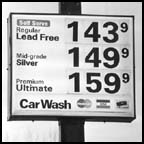 Paynesville has had the distinction of having the lowest gas prices in the area. However, with the rising price of gas, Paynesville's prices at local stations have risen along with the rest of the state.
Paynesville has had the distinction of having the lowest gas prices in the area. However, with the rising price of gas, Paynesville's prices at local stations have risen along with the rest of the state.Dave Lang, H&L Express manager, said he is just passing along the cost changes to customers that H&L has received. "I'm not sure why the gas prices are rising. It might have something to do with the price of crude oil tripling in the past year," Lang said.
Jim Guenther, Jim's Standard owner, said the $1.47 price is the highest that he has seen in a long time. "OPEC (Organization of Petroleum Exporting Countries) nations aren't producing as much crude oil," Guenther said. "We were spoiled with the low prices last year. Hopefully, the prices have leveled out."
However steady the gas prices may seem, Guenther says the prices are volatile and changing daily.
Rod Viessman, manager of Viessman Inc., Paynesville, said with the rising prices of diesel fuel, they have spent about a half million dollars more on fuel. Viessman Inc. owns more than 200 trucks in Minnesota and South Dakota.
Viessman said they charge their customers a surcharge which helps cover the fluctuating cost of diesel fuel. "We get a little reimbursement through the surcharge," he added.
Diesel fuel as of Feb. 25 was $1.43 at the pump.
Phyllis Nielsen, owner of Paynesville Motor and Transfer, said diesel fuel went from 70 cents a gallon in December 1998 to $1 a gallon in September 1999 to $1.22 on her latest billing. Nielsen explained she blends her fuel during the cold weather season.
Nielsen has an average of 19 school buses on the roads per day during the winter sports season. She said the fleet of buses burn an average of 180 gallons of fuel per day. "We have a 10,000 gallon tank at the bus garage and that doesn't last long," she said.
She estimates she has spent about $15,600 more on fuel this year than last year due to the rising prices.
Kenny Rohe, an independent trucker for AMPI, said they have a clause in their contract which covers the rising gas prices. "Everybody has a different contract, which helps cover the cost of fuel as the prices change," Rohe said.
Rohe remembers the Gulf War days when fuel was $1.50 per gallon. "By fall they are predicting the prices will be back to normal, $1.10 to $1.20," Rohe said. "I'm not fighting to make ends meet. The higher prices will affect younger drivers more."
Ian Pelton, a Paynesville resident who commutes to Willmar to work, said it pays to have a small car.
"My car suits me," he said. Pelton drives a Geo Metro which gives him 42 miles per gallon. "Every year that I can save money at the pumps is money in my pocket," Pelton said.
He has been commuting to work 18 years. "I used to drive a three-cylinder car which gave me 50 miles to the gallon, but it wore out," he added.
Pelton and Katie Lindquist share driving duties to Willmar, alternating turns driving.
"I can't fathom the concept of having a vehicle bigger than I need. It doesn't make sense," Pelton said.
Pelton recalls the 1974 oil embargo when gas prices jumped from 29 cents per gallon to $1. "People just freaked," he said.
According to the American Automobile Association (AAA), Minnesota motorists are getting a rude awakening at the gas pump, where gas prices have hit a nine-year high.
The current price of self-serve unleaded gasoline is $1.40, 14 cents higher than last month and 45 cents higher than last year, when the average price in Minnesota was 95 cents per gallon. AAA states, the current national average is $1.37, up 40 cents from last February.
In Minnesota, average gas prices in February of 1999 were 95 cents per gallon; $1.22 in August; $1.25 in September; $1.27 in October; $1.26 in November; and $1.28 in December.
Gasoline prices have risen to this high level in response to low inventories of crude oil and a per barrel price of more than $30 reached Feb. 16. According to AAA, the artifically induced shortage exists because nations aligned with OPEC have deliberately cut back oil production in a successful effort to raise global energy prices.